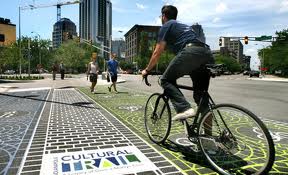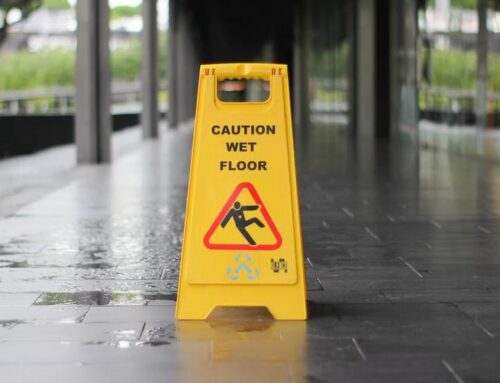While pedestrians often think they have the right-of-way, clearly only when they’re in designated crosswalks do they “more than likely” have the right-of-way. According to the National Highway Traffic Safety Administration (NHTSA) in 2009, 59,000 pedestrians were injured and 4,092 pedestrians were killed in car/pedestrian accidents. 76% of pedestrian deaths occurred at non-intersections. While vehicles clearly have the responsibility to watch out for and yield to pedestrians at intersections and crosswalks, pedestrians also have a responsibility to ensure that they cross the road at intersections, crosswalks and look before they cross to ensure that they’re not stepping into the path of an auto or truck.
Crossing between intersections in a way that interferes with traffic is considered “jaywalking” and could cause pedestrians injury or their life if they’re struck by a vehicle. Almost every State has laws concerning pedestrians and when they have the right-of-way. In the last reported statistics by the National Center for Statistics and Analysis it was found that 72% of the pedestrian fatalities occurred in an urban setting, and 75% of all pedestrian fatalities occurred at non-intersections. Most of the unexpected fatalities occurred during normal weather and the majority during the night time. In 2009, 25% of all children between the ages of 5 and 9 who were killed in traffic crashes were pedestrians. Children age 15 or younger counted for 7% of all pedestrian fatalities in that same year and 25% of all pedestrians injured in traffic. In 48% of all traffic crashes that result in pedestrian fatalities either the pedestrians or the drivers had a blood alcohol concentration generally higher than the legal limit.
Indiana Code 9-21-17 requires pedestrians to obey all traffic control signals. By ordinance pedestrians are prohibited from crossing a roadway in a business district or a highway except at a crosswalk. Walking or running into the path of a vehicle is prohibited but in the event a pedestrian is crossing the road at a point other than within the marked crosswalk or at an intersection, the pedestrian is required to yield the right-of-way to all vehicles on the roadway. Where a sidewalk is available a pedestrian is prohibited from walking or running along or upon a roadway. When a sidewalk is unavailable the pedestrian is allowed to use the shoulder of the road and as far as possible from the edge of the roadway. If there is no shoulder available the pedestrian must use the outside edge of the roadway. If you are a pedestrian on a roadway unless otherwise allowed, a pedestrian always has to yield the right-of-way to all vehicles on the roadway. In the event a pedestrian is blind, anyone who drives a vehicle has to yield the right-of-way to a blind pedestrian carrying a clearly visible white cane or accompanied by a guide dog. Anybody who violates any of these statutory requirements may very well commit a class C infraction.

Injuries suffered by pedestrians are often severe and typically include fractures, serious back injuries, internal organ injuries, head and brain injuries, scarring and death. If you or a family member are in a pedestrian accident it is vital to have an immediate investigation by an experienced personal injury lawyer. Preservation of evidence is often critical in proving a personal injury claim in a wrongful death case involving pedestrians.
With summer here and the increasing use of cell phones by motorists there could not be a better time to remind pedestrians to take precaution when walking. There has been a lot of discussion recently about pedestrians using cell phones and other electronic devices while they’re walking which may interfere with their ability to keep a vigilant lookout. To prevent a tragic automobile accident pedestrians should be aware of their surroundings, avoid walking while texting and make sure to be in the crosswalk if there’s one available when crossing the street. While we’ve all heard that pedestrians have the right-of-way a closer look at the law in Indiana and elsewhere reveals that this belief is not totally accurate. Pedestrians who do not cross where there is a marked crosswalk or at an intersection must yield the right-of-way and exercise vigilant care to avoid an accident.

The vast majority of pedestrian accidents in Indiana occurred in parking lots. There seems to be a difference in how carefully people drive in parking lots. You see people talking on their cell phones as soon as they start to back out of a parking lot space, or looking over their new purchases as they pull out talking to another person in the car. In any case the distraction in the close proximity of other vehicles and in some cases limited visibility frequently adds up to an accident. Parking lots are private property and as such the laws which apply to many vehicles on public roads don’t always apply. In addition you may have difficulty in getting police to respond to your call so you can document the accident. As they do occur on private property the insurance companies will decide who pays for what, so it’s essential that you get all the information you can and identify any witnesses that may be available if you believe the other party is at fault. You need to file your claim with both the police and your insurance company. For more information about how to file a claim with your insurance company, click here . Determination of whose at fault in a parking lot accident is often very difficult to determine. Often even low speed accidents will cause very serious injuries.
An example of such an accident occurred in Kokomo, Indiana on July 5, 2011, an 81-year-old Kokomo woman lost control of her vehicle at a credit union parking lot and struck and killed a pedestrian. Another example occurred in New Jersey in June of 2011, a 73 year old Johnsonville man was critically injured as a result of being struck in a parking lot of a convenience store. The vehicle struck him at a very low speed but it caused a very serious injury.






